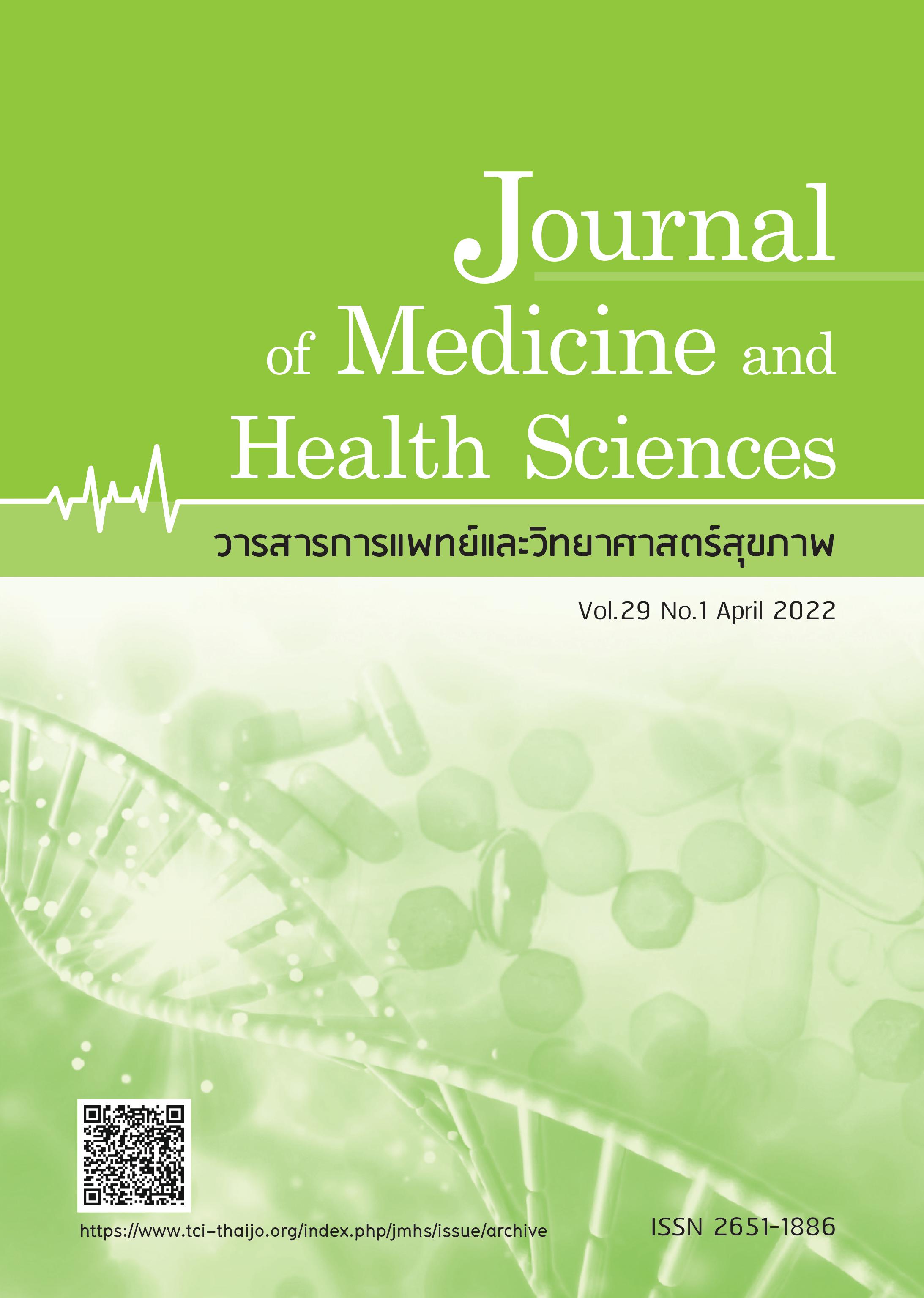Risk factors predicting intracerebral hemorrhage and prognosis of old age patients with mild traumatic brain injury in Hatyai hospital
Keywords:
elderly, mild traumatic brain injury, intracerebral hemorrhage, risk factorsAbstract
The incidence of mild traumatic brain injury among elderly patients tended to be
higher while delaying the diagnosis of intracerebral hemorrhage may create unfavorable clinical outcomes. Therefore, knowing the risk factors or predictive measurement of intracerebral hemorrhage and injury before the emergency department could benefit physicians in terms of decision-making regarding this population. The aim of this study was to identify the risk factors associated with intracerebral hemorrhages, and prognosis among elderly patients with mild traumatic brain injuries who were admitted to Hatyai hospital. A Retrospective study was conducted. The medical records of the elderly
patients, aged ≥60 and with mild traumatic brain injury (Glasgow Coma Scale: GCS of 13-15) from January 2016 to December 2020 were reviewed. The study included 501 patients with mean age of 71. Most of the patients were male (n= 254, 50.7%). The most common causes of their injuries were vehicle accidents, (n= 208, 41.5%) and falls (n= 273, 54.5%). Of those, 112 patients (22.4 %) had abnormal results for CT brain. The multivariate analysis showed that seven predictive clinical factors had statistically significant effects on positive CT brain, which included the following: 1) GCS <15; 2) headache; 3) post-traumatic vomiting more than two times; 4) transient loss of consciousness; 5) GCS drop ≥2; 6) clinical signs of skull fracture; and 7) clinical signs of fractures to the base of the skull. At least one clinical predicting factor was statistically significant to identify patients with abnormal intracranial findings in terms of sensitivity = 85.71%, specificity = 50.12% and AUROC = 0.68. Moreover, the normal results for CT scan had significant higher proportion of good prognosis than abnormal results.(p=0.009) Therefore, an elderly patient with mild traumatic brain injury should be carefully evaluated for clinical risk factors. If those risk factors are evident, then a CT brain should be considered.
References
Taylor CA, Bell JM, Breiding MJ, et al. Traumatic brain injury–related emergency department visits, hospitalizations, and deaths—United States, 2007 and 2013. MMWR Surveill Summ 2017;66:1.
Santiciensakul S, Rangpueng A. Situation of Severe Injury and Death from External Causes 2005-2010. Division of Epidemiology, Department of Disease Control; 2013.
Royal College of Neurosurgeons of Thailand. Clinical Practice Guidelines for Traumatic Brain Injury. Bangkok: Prosperous Plus; 2019.
Rakier A, Guilburd J, Soustiel J, et al. Head injuries in the elderly. Brain Inj 1995;9:187-94.
Ostermann RC, Joestl J, Tiefenboeck TM, et al. Risk factors predicting prognosis and outcome of elderly patients with isolated traumatic brain injury. J Orthop Surg Res 2018;13:1-6.
Seno S, Tomura S, Ono K, et al. Poor prognostic factors in elderly patients aged 75 years old or older with mild traumatic brain injury. J Clin Neurosci 2019;67:124-8.
Wolf H, Machold W, Frantal S, et al. Risk factors indicating the need for cranial CT scans in elderly patients with head trauma: an Austrian trial and comparison with the Canadian CT Head Rule. J Neurosurg 2014;120:447-52.
Mack LR, Chan SB, Silva JC, et al. The use of head computed tomography in elderly patients sustaining minor head trauma. J Emerg Med 2003;24:157-62.
Timler D, Dworzynski MJ, Szarpak Ł, et al. Head trauma in elderly patients: mechanisms of injuries and CT findings. Adv Clin Exp Med 2015;24:1045-50.
So WH, Chan HF, Li MK. Investigation of risk factors of geriatric patients with significant brain injury from ground-level fall: A retrospective cohort study in a local accident and emergency department
setting. Hong Kong J Emerg Med 2018;25:305-12.
Pages P-J, Boncoeur-Martel M-P, Dalmay F, et al. Relevance of emergency head CT scan for fall in the elderly person. J Neuroradiol 2020;47:54-8.
Mehta HB, Mehta V, Girman CJ, et al. Regression coefficient–based scoring system should be used to assign weights to the risk index. J Clin Epidemiol 2016;79:22-8.
Thairsc.com [Internet]: Road Accident Statistics in Thailand 2019;c2021 [updated 2021 June 30; cited 2021 Jul 30]. Available from: https://www.thairsc.com.
Lenell S, Nyholm L, Lewén A, et al. Clinical outcome and prognostic factors in elderly traumatic brain injury patients receiving neurointensive care. Acta Neurochir (Wien) 2019;161:1243-54.
Heydari F, Golban M, Majidinejad S. Traumatic brain injury in older adults presenting to the emergency department: epidemiology, outcomes and risk factors predicting the prognosis. Adv J Emerg Med 2020;4.
Moustafa F, Roubin J, Pereira B, et al. Predictive factors of intracranial bleeding in head trauma patients receiving antiplatelet therapy admitted to an emergency department. Scand J Trauma Resusc Emerg Med 2018;26:1-7.
Bouida W, Marghli S, Souissi S, et al. Prediction value of the Canadian CT head rule and the New Orleans criteria for positive head CT scan and acute neurosurgical procedures in minor head
trauma: a multicenter external validation study. Ann Emerg Med 2013;61:521-7.
Downloads
Published
How to Cite
Issue
Section
License

This work is licensed under a Creative Commons Attribution-NonCommercial-NoDerivatives 4.0 International License.



